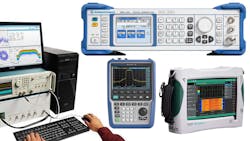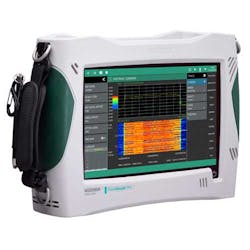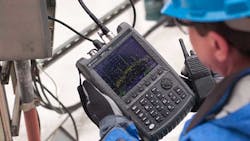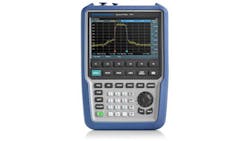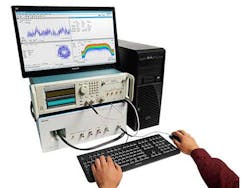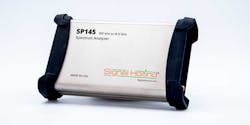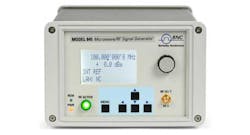State-of-the-Art Testers Chase Complex Wireless Signals
Members can download this article in PDF format.
What you’ll learn:
- Test setups must measure complex signals over large bandwidths.
- Consider portable, and even handheld, instruments for application versatility.
- Test equipment rentals can fill short-term measurement needs while avoiding obsolescence.
Wireless technology is synonymous with RF and microwave signal frequencies, although it’s steadily moving higher in frequency into the millimeter-wave (mmWave) range. As a result, the test equipment needed to design, develop, and maintain wireless products must constantly evolve to higher frequencies and more advanced signal formats.
With ever-increasing numbers of wireless products in use, competition grows for available frequency spectrum. It’s essential for testing to ensure that wireless devices designed to emit signals don’t exceed their limits and interfere with nearby equipment. Fortunately, high-frequency test equipment suppliers represent an innovative group that has developed effective measurement solutions for wireless testing. A sampling of such test gear is reviewed here.
Wireless equipment and systems are rapidly filling frequency spectrum, into the mmWave range and beyond. Growing demand for wireless electronic products is driving the development of test equipment capable of generating and analyzing complex signals quickly, over broad bandwidths for versatility.
As wireless products grow smaller in size with increasing functionality, networks must handle more of these devices simultaneously and wrestle with issues such as signal distortion and interference. Consequently, test-equipment developers are prompted to create instruments that can closely imitate the performance of any device under test (DUT) that they evaluate, even wireless gear that may be operating from a satellite.
The collection of wireless testers that follows provides a small sample of measurement equipment designed to maintain the operation of wireless applications as they embrace users worldwide.
5G Test Equipment
Fifth-generation (5G) New Radio (NR) wireless cellular networks are among the most visible of wireless applications. They connect portable telephones by the billions and add Internet of Things (IoT) sensors and other devices in commercial, industrial, medical, and military markets in large numbers.
Many wirelessly connected devices require greater numbers of base stations and wireless-local-area-network (WLAN) access points as well as additional frequency bandwidth. As 5G networks extend from the sub-6-GHz frequencies of frequency range 1 (FR1) to the mmWave frequencies of frequency range 2 (FR2), test equipment developers race to provide the signal analyzers and generators that can cover the frequency ranges for 5G’s many channels, from 410 to 7125 MHz for FR1 and 24.25 to 71.00 GHz for FR2.
Over-the-air (OTA) testing of 5G networks requires signal-analysis capability across increasingly broadband frequency ranges extending to mmWave frequencies. As an example, the Field Master Pro MS2090A real-time spectrum analyzer (RTSA) from Anritsu Co. is available in versions covering ranges between 9 kHz to 9 GHz and 9 kHz to 54 GHz, with natural mechanical differences such as Type N connectors in the 9-GHz version and 1.85-mm V connectors in the 54-GHz version. All offer a 5G NR demodulation mode to ease 5G wireless testing.
These compact portable analyzers (Fig. 1) function for about two hours on a battery charge and show results on a 10.1-in. color touchscreen display screen. With analysis bandwidths as wide as 110 MHz, they’re as well-suited for wireless communications measurements such as for pulsed radar testing. The RTSAs can perform a variety of test applications, including broadband transmitter signal analysis, satellite-communications (satcom) system monitoring, microwave radio-link testing, and spectrum monitoring and interference hunting.
When equipped with a preamplifier, the analyzers can detect and display extremely low-level signals, for example from a test antenna, by merit of a displayed average noise level (DANL) of −164 dBm. A free downloadable software tool for a PC simplifies remote spectrum monitoring.
Anritsu recently announced a solution to conformance testing of the multitude of devices that will occupy the 5G FR1 under-6-GHz frequency range—the MR7873NR Lite tester. It performs the 5G FR1 certification testing per Third-Generation Partnership Program (3GPP) communications standards.
It accounts for the scheduling of frequency bands for the many wireless functions supported by the multiple frequency bands within the sub-6-GHz FR1 range. The complete test system is capable of transmitting and receive testing for the many modulation formats of signals in wireless systems, including for cellular, WLAN, and IoT devices.
More Analyzers Become Portable
Keysight Technologies offers a wide range of benchtop and portable/handheld spectrum and signal analyzers (as well as compact portable packages that combine analyzers with signal generators for comprehensive wireless testing). The FieldFox handheld analyzers weigh just 7.35 lbs. but are more like complete measurement laboratories than handheld spectrum analyzers.
Each battery-powered unit contains a swept-frequency spectrum analyzer, an RTSA, a GPS receiver, power meter, interference analyzer, and even offers an option for a vector network analyzer (VNA) to perform S-parameter measurements. Models come with frequency ranges as low as 30 kHz to 4 GHz and as high as 30 kHz to 54 GHz. The RTSAs can study analysis bandwidths as wide as 40 or 120 MHz and detect signals as brief as 47 ns.
With such broad frequency coverage, FieldFox portable analyzers are available for in-field OTA measurements within both frequency ranges (FR1 and FR2) of 5G wireless networks (Fig. 2). They feature excellent amplitude accuracy of ±0.2 dB over broad dynamic ranges.
Using USB connections to a PC running the Keysight Spectrum Management Software (KSMS), the analyzers can implement a spectrum emission mask (SEM) to measure in-band and out-of-band EM energy within set bandwidths when searching for interference. The software supports various applications, including satcom monitoring. For chasing pulses, the analyzers can operate with video triggers and external triggers and set time gates from 6 μs to 1.8 s.
The R&S Spectrum Rider FPH handheld spectrum analyzers (Fig. 3) from Rohde & Schwarz come in versions covering 5 kHz to 2 GHz and as high as 5 kHz to 44 GHz, all with 1-Hz frequency resolution. The instruments measure frequency spans from 10 Hz to 600 MHz with sweep times ranging from 20 ms to 1000 s. RBWs can be set from 1 Hz to 3 MHz, and a DANL of −150 dBm or better (with internal preamplifier) enables detection of low-level signals. The portable analyzers run as long as 4.5 h on a battery charge.
The company also developed its R&S ESMW ultrawideband monitoring receiver for spectrum monitoring from 8 kHz to 40 GHz. With real-time bandwidths as wide as 2 GHz, it’s designed to capture broadband wireless signals even in highly populated, high-density spectrum environments.
The RSA7100A and RSA7100B RTSAs (Fig. 4) from Tektronix are available from 16 kHz to 14.0 GHz or 16 kHz to 26.5 GHz with standard maximum acquisition bandwidth of 320 MHz and optional maximum acquisition bandwidth of 800 MHz. The RTSAs measure signal levels as high as +30 dBm and as low as −145 dBm. Built-in attenuators provide as much as 75-dB attenuation to 26.5 GHz. The spectrum analyzers come with or without a GPS receiver and can perform a wide range of automatic measurements with the company’s SignalVu-PC software.
Portable and Modular Testers
As electronic products are being designed for miniaturization with increased functionality, wireless test instruments are following that trend in portable and modular packages with increased measurement performance and capabilities for their small sizes.
For example, the model SP145 from Signal Hound packs multiple measurement functions, including a swept-frequency spectrum analyzer and RTSA, into a compact portable unit operated by software on a PC via USB connections (Fig. 5). It has a frequency range of 100 kHz to 14.5 GHz and sweep speeds to 200 GHz/s to capture even brief signal events over wide frequency spans. With a DANL of –160 dBm, it can detect and display low-level signals of interest.
Supplied with the company’s free Spike test software, it’s compatible with PCs containing MS Windows or the Linux operating system (OS). Signal Hound recently announced its model SM435B/C RTSAs with frequency coverage into the mmWave range, from 100 kHz to 43.5 GHz.
Siglent is another supplier of portable handheld spectrum analyzers suitable for wireless testing. The SSA5000A series analyzers cover a range of 9 kHz to 26.5 GHz. They can work as spectrum analyzers to gauge signal amplitudes and as vector signal analyzers and transceivers to study signal amplitude and phase.
Modular systems such as the PXIe-5644 vector signal transceiver (VST) from NI test wireless systems with massive-input, massive-output (MIMO) antenna configurations. The VST’s PXI format enables users to slide modules as needed into a mainframe chassis to achieve the required measurement capability.
Dealing with Signal Overlap
As the density of wireless devices and their signals increases, opportunities for signal overlap and interference also increase, such as between 5G and WLAN systems with Wi-Fi equipment based on the IEEE 802.11 protocol. With WLANs operating in the unlicensed ISM band along with similar short-range wireless technologies such as Bluetooth and Zigbee, WLAN testing helps ensure stable operation in such dense signal environments.
The latest (sixth) generation of Wi-Fi devices (Wi-Fi 6E) reach 7.125 GHz. Wireless testers for evaluating WLAN signals and products must support applications extending higher in frequency (the seventh Wi-Fi generation is under development) and sharing spectrum with other wireless devices. A microwave oven leaking EM energy at 2,450 MHz, for example, can degrade the performance of a WLAN receiver.
Many of the spectrum analyzers reviewed earlier can act as Wi-Fi or WLAN receivers to analyze signal quality in a WLAN system. When more specialized test solutions are required, equipment such as the model MT8862C Wireless Connectivity Test Set from Anritsu Co. is well-suited to evaluate the performance of DUTs under typical WLAN operating conditions.
The MT8862C is a benchtop instrument with multiple test channels and frequency bands required for IEEE 802.11 WLAN testing, supporting testing at 2.4- and 5.0-GHz WLAN frequency ranges. It can be set for the many channels defined by the protocol within both frequency ranges and characterizes data rates to 54 MB/s possible with WLAN’s orthogonal-frequency-division-multiplex (OFDM) transmissions. It’s able to test WLAN DUTs and access points; two of the test sets can be combined for 2 × 2 MIMO testing.
The CMP180 Radio Communications Tester from Rohde & Schwarz performs Wi-Fi 6E and 5G cellular testing to 8 GHz, including MIMO antenna testing. It incorporates two separate vector signal generators and two vector signal analyzers as well as a power supply and controller within a compact housing. Each of the two RF channels has eight ports for a total of 16 RF test ports with bandwidths as wide as 500 MHz.
Another test platform for Wi-Fi 6E is the model E6680E Wireless Test Set from Keysight Technologies. It also has 16 RF ports for testing multiple antennas and MIMO configurations. It combines a vector signal analyzer and vector signal generator both with CW frequency range of 380 to 7,535 MHz and 1-Hz frequency resolution. The compact test set delivers a wide dynamic range for its broad frequency coverage, from −70 to +30 dBm, with ±0.75 dB or better amplitude accuracy.
The company has also developed portable testers that operate according to the IEEE 802.11 WLAN communications protocol. One example is the AV1021A WaveBee Touch handheld analyzer for vehicle-to-vehicle (V2V) and vehicle-to-everything (V2X) mobile wireless communications testing.
Generating Signals
Many companies developing wireless signal analyzers produce signal generators that enable emulation of modulated signals within wireless systems. For example, Berkeley Nucleonics Corp. may not be known for a WLAN analyzer, but the firm does produce the 845 fast-switching microwave signal generator (Fig. 6) with all major modulation formats. In addition, modulation such as amplitude modulation (AM) and pulse modulation can be combined to create signals for realistic radar devices and system testing.
The signal generator comes in versions from 9 or 100 kHz to 12.0, 20.0, or 26.5 GHz with impressive 0.001-Hz frequency resolution. Signal power ranges from −20 to +15 dBm in standard models, with an option for −90 to +25 dBm. Both ranges can be adjusted with 0.01-dB resolution. The signal source has 400-µs standard switching speed, which can be accelerated to 30 µs as an option. While the flexible signal generator runs on standard AC power, it can also operate on battery power for in-field measurements.
The SMB100A signal generator from Rohde & Schwarz is also available in multiple versions from 100 kHz to 12.75, 20.00, 31.80, or 40.00 GHz, and can be extended to 110 GHz with a frequency multiplier (Fig. 7). It’s well-equipped with modulation, including pulse modulation, and can control signal output-power levels from −120 to +27 dBm (for units with a step attenuator). The VXG M9384B and VXG-m M9383B signal generators from Keysight Technologies come in versions covering 1 MHz to 14.0, 20.0, 31.8, or 44.0 GHz with 0.01-Hz frequency resolution and 0.01-deg. phase control of a ±180-deg. phase range.
Testing Services
In crowded operating environments such as large cities, wireless applications like 5G and Wi-Fi may overlap in frequency and wireless products must be tested according to standards including ANSI C63.27 to ensure their wireless coexistence capabilities. Fortunately, rather than selling test equipment, some companies offer wireless testing services for applications such as 5G and Wi-Fi, or wireless coexistence testing.
Spirent is known for extensive Wi-Fi test services, while F2 Labs performs UL and CSA certifications as well as FCC Part 15 certifications for wireless emitters including Wi-Fi. Eurofins MetLabs provides test services for U.S. and international wireless system requirements. And RF Exposure Lab has been certified for test services through mmWave frequencies.
GL Communications Inc. offers services and equipment for voice, data, and video testing of mobile wireless networks including 5G systems. Performance and conformity testing can be combined during 5G drive testing in a car. The firm’s Universal Test Platform holds as many as six modules for different combinations of wireless test functions, while its Message Automation and Protocol Simulation (MAPS) software supports a variety of wireless-communications protocols, including satcom echo delay measurements.
For wireless measurement applications that can be performed periodically, test equipment rentals provide a way to acquire the measurement capability needed for an application while avoiding obsolescence as wireless frequency bands continue to increase. Companies offering test equipment rentals include Axiom Test Equipment, ElectroRent, and TRS-Rentelco.
Wireless testing sometimes requires connecting cables, such as with the TXG200 WLAN network test kit from Platinum Tools. The kit tests copper and fiber-optic cables in WLAN systems. It can measure Wi-Fi signal strength and cable lengths within a network and perform Ethernet speed certifications to 10 Gb/s. The kit includes the company’s XG2 tester, chargers, patch cables, and carrying case.
About the Author
Jack Browne
Technical Contributor
Jack Browne, Technical Contributor, has worked in technical publishing for over 30 years. He managed the content and production of three technical journals while at the American Institute of Physics, including Medical Physics and the Journal of Vacuum Science & Technology. He has been a Publisher and Editor for Penton Media, started the firm’s Wireless Symposium & Exhibition trade show in 1993, and currently serves as Technical Contributor for that company's Microwaves & RF magazine. Browne, who holds a BS in Mathematics from City College of New York and BA degrees in English and Philosophy from Fordham University, is a member of the IEEE.
